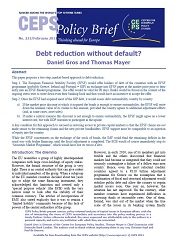№233. Debt reduction without default?
№233. Debt reduction without default?
Author(s): Thomas Mayer, Daniel Gros
Subject(s): National Economy, Economic policy, Political economy, EU-Approach / EU-Accession / EU-Development, Financial Markets
Published by: CEPS Centre for European Policy Studies
Keywords: Debt reduction; European Financial Stability Facility (EFSF); Financial market; market prices; GIP debt;
Summary/Abstract: This paper proposes a two-step, market-based approach to debt reduction: Step 1. The European Financial Stability Facility (EFSF) would offer holders of debt of the countries with an EFSF programme (probably Greece, Ireland and Portugal = GIP) an exchange into EFSF paper at the market price prior to their entry into an EFSF-funded programme. The offer would be valid for 90 days. Banks would be forced in the context of the ongoing stress tests to write down even their banking book and thus would have an incentive to accept the offer. Step 2. Once the EFSF had acquired most of the GIP debt, it would assess debt sustainability country by country. a) If the market price discount at which it acquired the bonds is enough to ensure sustainability, the EFSF will write down the nominal value of its claims to this amount, provided the country agrees to additional adjustment efforts (and, in some cases, asset sales).b) If under a central scenario this discount is not enough to ensure sustainability, the EFSF might agree on a lower interest rate, but with GDP warrants to participate in the upside.
Series: CEPS Policy Briefs
- Page Count: 13
- Publication Year: 2011
- Language: English
- Content File-PDF

